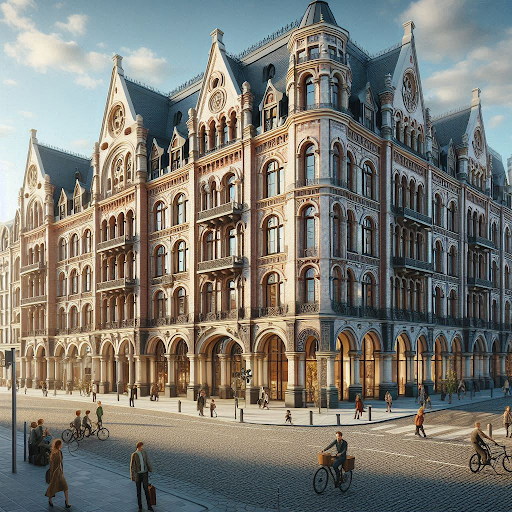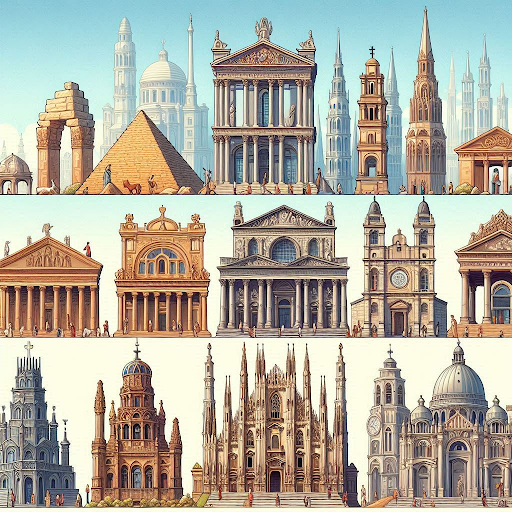Architecture is a reflection of the cultural, technological, and philosophical evolution of societies through history. Each architectural period represents unique design principles, materials, and aesthetics that define the era in which they were created. This blog explores the major architectural periods and styles that have shaped our built environment.
1. Prehistoric Architecture
1.1. Megalithic Architecture
- Timeframe: Circa 4000 BCE – 2000 BCE
- Characteristics: This period is marked by the use of large stones (megaliths) arranged in various formations. Examples include Stonehenge in England and the dolmens of Korea and France
- .Significance: These structures often served ceremonial or religious purposes, and their precise construction methods reflect the advanced understanding of engineering and astronomy of the time.

2. Ancient Architecture
2.1. Egyptian Architecture
- Timeframe: Circa 3000 BCE – 30 BCE
- Characteristics: Known for its monumental structures, such as pyramids, temples, and tombs. The use of massive stone blocks, and the development of the post-and-lintel system are notable.
- Significance: Egyptian architecture aimed to honor gods and ensure the pharaohs’ passage to the afterlife. Iconic examples include the Pyramids of Giza and the Temple of Karnak.

2.2. Greek Architecture
- Timeframe: Circa 900 BCE – 30 BCE
- Characteristics: Emphasized proportion, symmetry, and the use of columns. Three distinct styles emerged: Doric, Ionic, and Corinthian.
- Significance: Greek architecture laid the foundations for classical design principles. Key examples include the Parthenon in Athens and the Temple of Zeus at Olympia.

2.3. Roman Architecture
- Timeframe: Circa 500 BCE – 476 CE
- Characteristics: Innovation in engineering with the use of concrete, arches, and domes. Roman architecture featured grand structures like aqueducts, amphitheaters, and basilicas.
- Significance: Roman architecture adapted and expanded upon Greek principles, leading to the development of monumental public buildings. The Pantheon and the Colosseum are notable examples.

3. Medieval Architecture
3.1. Byzantine Architecture
- Timeframe: Circa 330 CE – 1453 CE
- Characteristics: Characterized by the use of domes, mosaics, and intricate decorative elements. The interior of buildings often featured elaborate mosaics and iconography.
- Significance: Byzantine architecture influenced the development of Eastern Orthodox churches. The Hagia Sophia in Istanbul is a prime example of this style.

3.2. Romanesque Architecture
- Timeframe: Circa 800 CE – 1100 CE
- Characteristics: Features rounded arches, thick walls, and small windows. The design was heavy and solid, with a focus on fortification and stability.
- Significance: Romanesque architecture represents the transition from the ancient to the medieval world. Key structures include the Abbey of Cluny in France and Durham Cathedral in England.

3.3. Gothic Architecture
- Timeframe: Circa 1100 CE – 1500 CE
- Characteristics: Known for its verticality, flying buttresses, ribbed vaults, and large stained-glass windows. Gothic cathedrals are characterized by their soaring spires and intricate ornamentation.
- Significance: Gothic architecture reflects the religious fervor and the growth of cities during the Middle Ages. Notable examples are Notre-Dame de Paris and Chartres Cathedral.

4. Renaissance Architecture
4.1. Early Renaissance
- Timeframe: Circa 1400 CE – 1500 CE
- Characteristics: Marked by a return to classical forms and principles, emphasizing symmetry, proportion, and perspective.
- Significance: This period represents the rebirth of classical architecture. Key figures include Filippo Brunelleschi and Leon Battista Alberti. The Florence Cathedral and the Palazzo Medici are notable examples.

4.2. High Renaissance
- Timeframe: Circa 1500 CE – 1530 CE
- Characteristics: The culmination of Renaissance ideals, with harmonious proportions and the use of classical elements. Buildings were grand and emphasized balance and order.
- Significance: High Renaissance architecture includes masterpieces like St. Peter’s Basilica by Michelangelo and the Tempietto by Bramante.

4.3. Mannerism
- Timeframe: Circa 1530 CE – 1600 CE
- Characteristics: Known for its sophisticated, sometimes exaggerated forms and unusual proportions, breaking away from Renaissance norms.
- Significance: Mannerist architecture explores new forms and spatial compositions. Notable examples include the Palazzo del Te in Mantua by Giulio Romano.

5. Baroque Architecture
- Timeframe: Circa 1600 CE – 1750 CE
- Characteristics: Characterized by dramatic use of light and shadow, bold ornamentation, and a sense of movement. The style often aimed to evoke emotional responses.
- Significance: Baroque architecture reflects the power and influence of the Catholic Church and the absolute monarchy. St. Peter’s Basilica’s dome and the Palace of Versailles are iconic examples.

6. Neoclassical Architecture
- Timeframe: Circa 1750 CE – 1850 CE
- Characteristics: A revival of classical architecture, emphasizing simplicity, symmetry, and the use of columns and pediments.
- Significance: Neoclassical architecture is associated with the Enlightenment and the desire to return to classical ideals. Examples include the Panthéon in Paris and the U.S. Capitol building.

7. Modern Architecture
7.1. Early Modern
- Timeframe: Circa 1900 CE – 1930 CE
- Characteristics: Focused on functional design, the use of new materials like steel and glass, and the rejection of historical styles.
- Significance: Early modern architecture marks a departure from ornamentation and embraces simplicity and functionality. Notable examples include the Bauhaus School and Le Corbusier’s Villa Savoye.

7.2. International Style
- Timeframe: Circa 1920 CE – 1970 CE
- Characteristics: Emphasizes minimalism, geometric forms, and a lack of ornamentation. Buildings often feature flat roofs, open floor plans, and glass facades.
- Significance: The International Style reflects the global nature of modernism and is seen in structures like the Seagram Building in New York and the Glass House by Philip Johnson.

8. Postmodern Architecture
- Timeframe: Circa 1970 CE – Present
- Characteristics: A reaction against the austerity of modernism, featuring eclectic styles, historical references, and playful forms.
- Significance: Postmodern architecture embraces diversity and complexity, often incorporating elements from previous styles. The Guggenheim Museum in Bilbao and the Portland Building are key examples.

Conclusion
Architecture is a dynamic field that evolves with human society, reflecting changes in culture, technology, and philosophy. From the monumental structures of ancient civilizations to the playful forms of postmodernism, each architectural period provides insight into the values and innovations of its time. By studying these periods, we gain a deeper appreciation for the built environment and the diverse ways in which humans have shaped their world.

